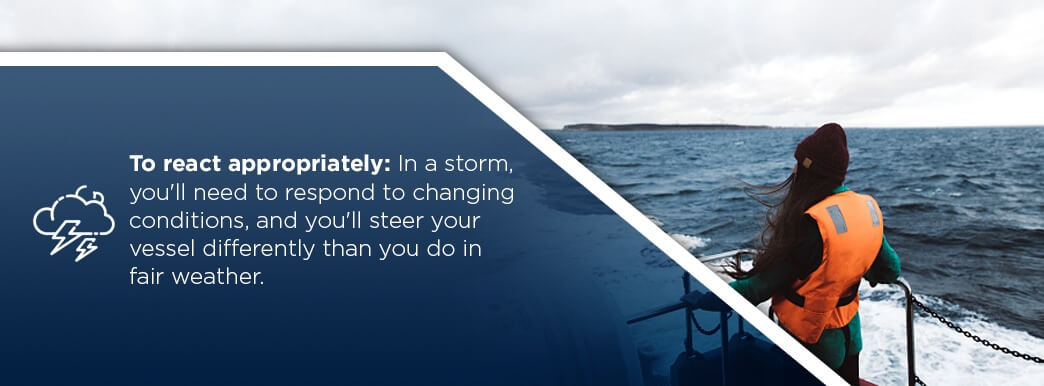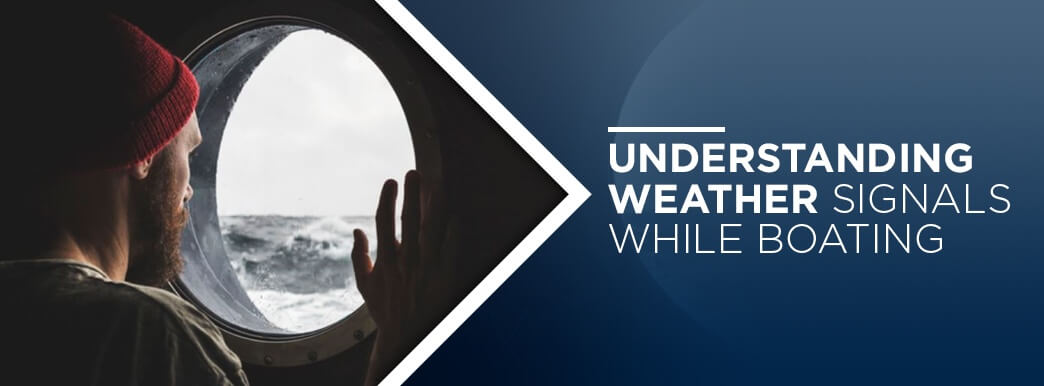
While boating, just about everyone wants to have an idyllic day on the water. Whether you’re relaxing on deck in the sun, fishing, hopping into the water to take a swim or zooming around in a powerboat and enjoying the speed and the clear blue sky, a day on the water should be enjoyable and stress-free.
Many boat outings start that way. But even the most glorious day on the water can turn rough and stormy. When this happens, boats are at significant risk, especially smaller boats like pleasure crafts. According to the U.S. Coast Guard, in 2018, poor weather contributed to over 205 boating accidents, 40 boating deaths and 96 boating injuries.
Fortunately, you can take steps to keep your boat from ending up as a poor-weather statistic. Knowing how to read the weather while boating is a critical step in keeping yourself, your boat and your passengers safe.
Importance of Understanding Weather Conditions While Boating
Bad weather while boating can ruin an outing in a heartbeat. Storms can come up in an instant, and they can turn a beautiful, calm day into an emergency situation, putting both safety and lives at risk.
Small craft like motorboats are particularly vulnerable in storms and squalls. Because of its bulk, an ocean liner may be able to weather a fierce storm with little trouble, but lighter pleasure craft will struggle against strong wind and waves. So if you’re out on a powerboat or cabin cruiser, it’s vital for several reasons to keep an eye on the weather conditions and understand what they portend:
Gives Yourself Time To Seek Shelter
Storms blow in fast, but they rarely come up without any warning. By keeping an eye on weather conditions, you can anticipate a turn in the weather before you find yourself stuck in the middle of a storm. That way, you’ll give yourself time to get to shore.
Helps You React Appropriately
In a storm, you’ll need to respond to changing conditions, and you’ll steer your vessel differently than you do in fair weather. Understanding the conditions around you helps you react quickly and accurately to keep your boat on course and upright.
Helps You Keep Your Boat and Passengers Safe
In a sudden storm, your boat is in danger of swamping, foundering, capsizing, running aground or colliding with objects the storm hurls into your path. Strong winds can blow your boat off course or create choppy wave conditions that could end up capsizing your vessel. And heavy fog dramatically reduces visibility and increases your chances of running aground. Anticipating these conditions before they occur helps you ensure that your boat and passengers make it back to shore safely.
How to Monitor, Interpret and Prepare for Adverse Weather Conditions
You can help increase your understanding of weather conditions in a couple of simple, practical ways:
Use Your Barometer
A barometer measures barometric pressure, which is a reliable predictor of coming weather conditions. Take barometer readings every hour or two, or more often if the situation looks dicey. Make a note of what the mercury — that is, the barometric pressure — is doing. If the barometric pressure is high and rising, the weather is likely to be fine for a while. If the barometric pressure is falling, particularly if it is low and falling rapidly, the conditions are right for a storm to blow in.
Tune In To NOAA Weather Forecasts
You should always have a radio on the boat that broadcasts National Oceanic and Atmospheric Administration weather forecasts. Make sure your radio has fresh batteries and is in good working order — accurate, up-to-date knowledge of incoming weather can make the difference between a fun boating trip and a nightmarish one. Check the marine forecast often, up to every half hour if the weather looks as if it might turn poor.
Also, it’s always essential to make sure your boat has life-saving supplies on board, such as life jackets, a first aid kit, sailing knives, extra fuel and emergency lights and flares. A GPS unit, navigational charts and a handheld compass are helpful additions as well. These tools will aid you if you lose power and cannot use your electrical navigation systems. Understanding the weather conditions and how to handle a boat in them is critical. But make sure you also set yourself up for success in these conditions by keeping the proper equipment and supplies on board.
Weather Signs and Hazards to Look For
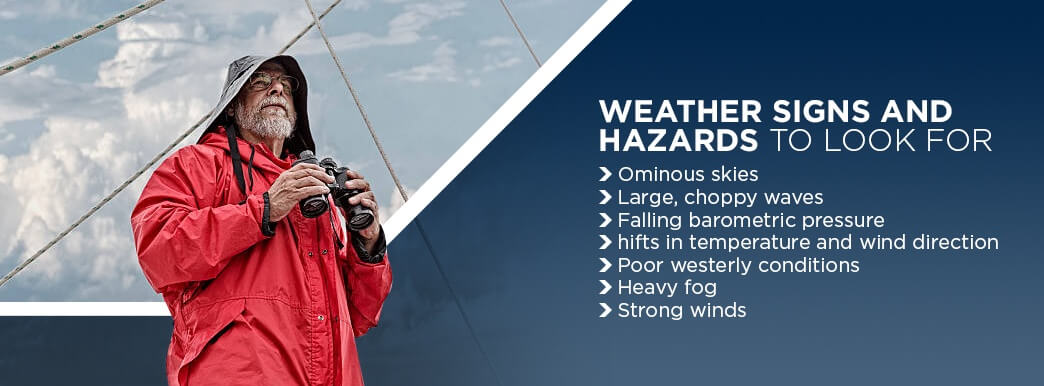
What indicates foul weather is approaching when you are boating? Look for these signs to help determine whether the weather will be fine or whether you should stay off the water.
- Ominous skies: Keep an eye on the sky and make sure its appearance hasn’t taken a threatening turn. Thick, dark clouds rolling in usually indicate a storm afoot. Also watch for a “lowering ceiling,” where heavy, flat-bottomed clouds seem to drop lower and lower in the sky.
- Large, choppy waves: Monitor the waves as you’re boating. Depending on your location, some waves may be expected, but extremely choppy waves usually indicate a storm on the horizon. If that’s the case, head for shelter as soon as you can.
- Falling barometric pressure: If your boat has an onboard barometer, keep an eye on the barometric pressure readings, and take particular note if the pressure starts to fall. Rising barometric pressure is a good sign, but falling barometric pressure generally indicates that a storm is on the way. Typically, a barometric pressure of 29.83 and falling is a good indicator of an imminent storm.
- Shifts in temperature and wind direction: Some variability is natural, but enormous shifts in temperature and wind direction generally indicate the approach of bad weather.
- Poor westerly conditions: Keep on eye on the sky and water conditions in the west and southwest, in particular. Because of the direction of the prevailing winds across North America, storms often blow up out of the west or southwest. If you see dark clouds start to pile up on the western horizon, it’s probably time to think about heading in.
- Heavy fog: If you see heavy fog starting to approach from any direction, it’s a good idea to head for shore. Dense fog can reduce visibility and increase the chances of running aground.
- Strong winds: Strong wind gusts themselves can be dangerous to a boat, but they are also good indicators that a storm is about to blow through. If strong winds are buffeting your vessel, think about cutting your time on the water short to be safe.
In addition to keeping an eye on physical signs of poor weather, don’t forget to attend to all the information available to you as well.
- Marine forecasts: It’s crucial to monitor marine forecasts so you don’t end up boating on rough waters. Marine forecasts are readily available over the radio, so make sure you tune in. NOAA information covers all of the coastal United States and is updated frequently with the latest predictions from forecasting models. It also gives information about temperature, humidity, wave conditions, wind direction and speed and barometric pressure. Be sure to tune into channels 16 and 22A, which broadcast NOAA weather radio, or consider investing in a VHF-FM radio with a built-in NOAA weather channel.
- Behavior of other boaters: If the skies look clear enough and the wind isn’t too bad, but suddenly all the boaters around you are heading for shore, don’t ignore the warning. Especially if you’re in an unfamiliar area where weather conditions may change quickly, it’s a good idea to follow the herd.
- Small craft advisories: To avoid getting caught in dangerous situations, you should heed the flags and lights that indicate small craft advisories. Typically, the National Weather Service issues small craft advisories when the wind speeds are between 20 and 33 knots — the exact number varies by area.
- Hurricane warnings: Of course, you definitely don’t want to be on the water when a hurricane warning is in effect. Pay attention to hurricane watches that go into effect, and if they turn into hurricane warnings — or even if they don’t — be sure to keep off the water to avoid incredibly hazardous weather for boating.
Navigating Rough or Stormy Waters
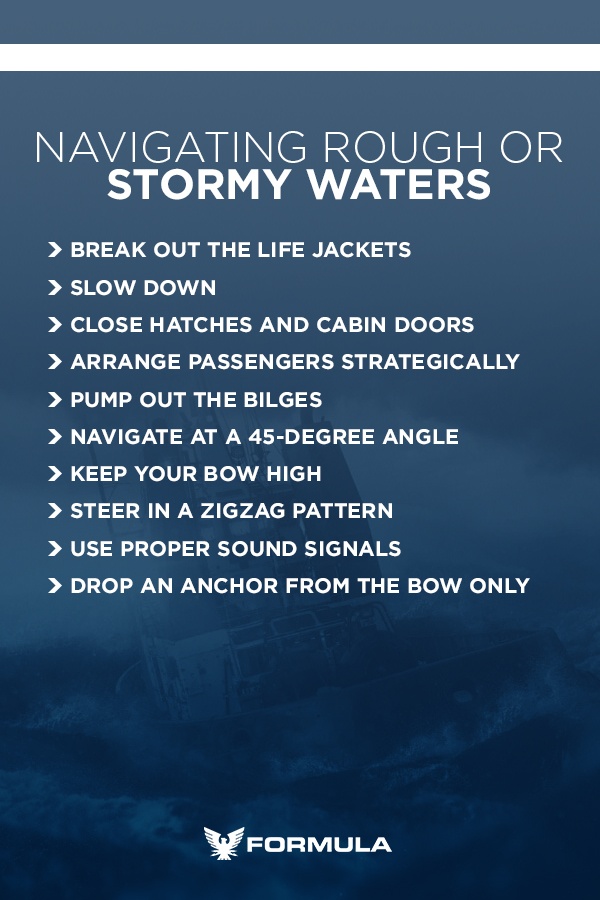
In their enthusiasm to hit the water, many boaters head straight for the cockpit without learning the proper steps and techniques for navigating stormy weather. If you boat with any frequency, chances are good that you’ll run into rough waters at some point, and being confident of your abilities in these conditions is crucial, both for you and your boat and for the safety of your passengers.
It’s never fun to have your boat caught in a storm, but knowing how to handle your boat in stormy weather can make the difference between losing your boat and making it safely to shore. When using the tips below, it’s also imperative to remain calm. It may be difficult, but staying calm helps keep your head clear so you can react thoughtfully and make the best decisions, no matter what nature throws at you.
Break Out the Life Jackets
When a storm rolls in, don’t take chances with your safety or that of your passengers. Get out the life jackets and make sure everyone is wearing one, just in case.
Slow Down
Although you might be inclined to speed toward shore to outrun the storm, high speeds, high winds and choppy waves never mix well. Reduce your speed to give your boat its best chance of handling the rough conditions.
Close Hatches and Cabin Doors
Have you ever heard the command, “Batten down the hatches!” while watching an old sailing movie? In the old days, ships’ hatches were covered with open wooden gratings when not in use. When a storm blew up, sailors would make their ships secure against bad weather by removing the wooden gratings, covering the hatches with taut canvas and then nailing wooden battens over the hatches to make the covering watertight. Nowadays, you can close your hatch doors — but it’s crucial to do so. Otherwise, your boat might take on water and sink.
Arrange Passengers Strategically
In a storm, it’s imperative for your boat to maintain a low and balanced center of gravity. In severe weather, passengers can help by hunkering down and keeping away from the gunwales and close to the midline.
Pump Out the Bilges
In a storm, you want your boat to sit as high as possible in the water so it doesn’t go under. But navigating rough waters often means your boat takes on water over the bow and gunwales, which can lower your boat. Pumping out the bilges removes weighty liquid and helps the boat sit higher and more securely.
Navigate at a 45-degree Angle
As you steer toward a safe harbor, steer into the waves, keeping the prow of the boat at a 45-degree angle. If you run your boat straight into the waves, they are likely to capsize it. Running parallel to the waves incurs the same risk. Keeping your boat at a steady 45-degree angle helps the boat maintain the most stable position and reduces the risk of capsizing in strong waves.
Keep Your Bow High
This may seem easier said than done, but to keep your boat from swamping, you’ll need to keep your boat as high in the water as possible rather than letting waves crash over the bow.
Steer In a Zigzag Pattern
Navigating your boat in a zigzag pattern, keeping your bow high, can often help you steer clear of the worst waves.
Use Proper Sound Signals
In a dark storm, torrential rain or heavy fog, you and other boaters will have limited visibility. Other boats may not have much warning to get out of your way, or they may be so focused on navigating the storm that they don’t have attention to spare for figuring out your intentions. It’s essential to let other vessels know of your proximity and intentions so you can prevent a collision. Use sound signals such as horn blasts to inform other boats of your whereabouts in a blind area, indicate to other boats that you want to pass them or signal that you are in distress.
Drop An Anchor from the Bow Only
If your engine stops functioning, you may need to drop an anchor to keep the boat from drifting and foundering. Always drop anchor from the bow — never from the stern. The additional weight could drag the stern down and cause the boat to founder.
Contact Formula Boats to Learn More About Our Boat Models
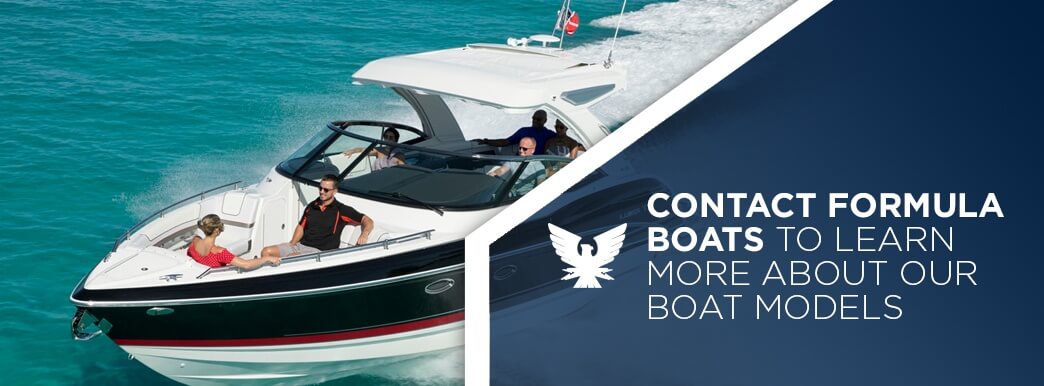
If you’re serious about boating or just like to have some serious fun on the water, there’s a good chance that at some point you’ll be out boating in bad weather. When that happens, you’ll need to be competent in handling your vessel, but you also need a boat you can rely on to weather the storm and get you safely to shore.
Formula Boats has what you’re looking for. Our customizable boats feature expert craftsmanship and exquisite design, so they’re sleek and powerful enough for thrills on the water, and they’re durable and reliable in rough weather.
Check out our “Build Your Boat” feature online, where you can play around with different styles of boats, specifications and features. Or contact us today to start making your dream boat a reality.

